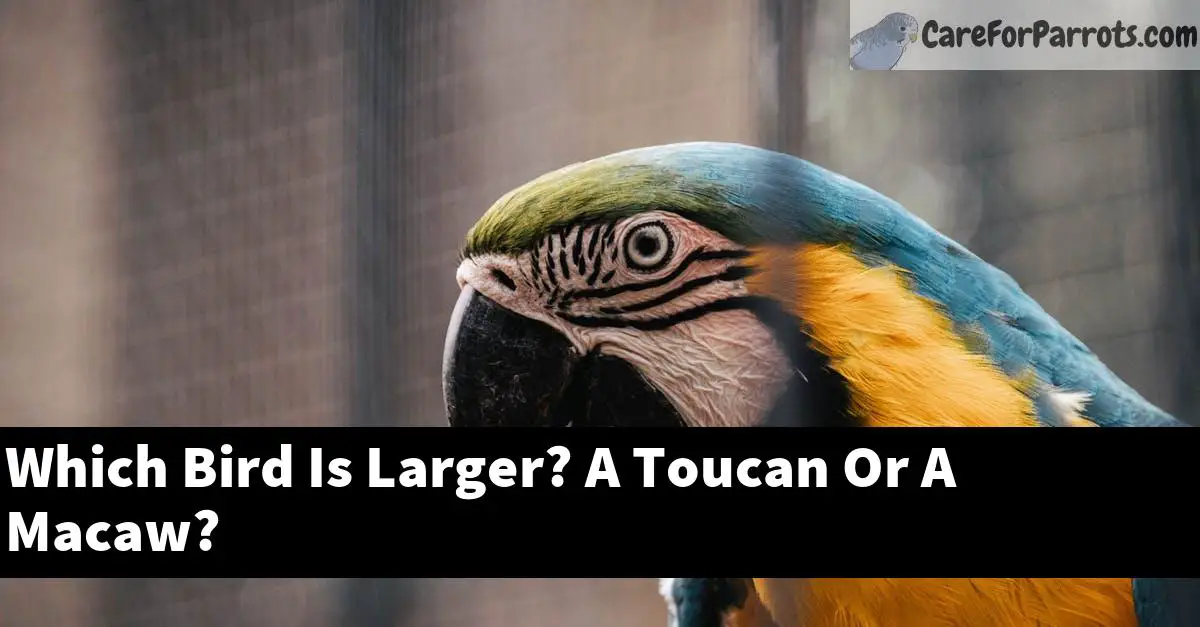When it comes to the fascinating world of tropical birds, two species that often capture our attention are the toucan and the macaw. Both of these birds are known for their striking colors, unique features, and captivating personalities.
But have you ever wondered which of these two birds is larger?
In this article, I will explore the size, weight, wingspan, and various other aspects of the toucan and the macaw to determine which bird comes out on top in terms of size.
Table of Contents
Physical Features
Toucan
Toucans are part of the Ramphastidae family, and there are about 40 different species of toucans. They are easily recognized by their large, colorful bills, which can make up almost half of their body length. Their plumage is typically black with vibrant splashes of color on their throat, chest, and rump.
Macaw
Macaws belong to the Psittacidae family and are among the most colorful and recognizable parrots. They are known for their striking plumage, powerful beaks, and long, tapered tails. Macaws range in size from the small Hahn’s macaw to the impressive hyacinth macaw, which is the largest flying parrot species in the world.
Size Comparison
Toucan
Toucans vary in size depending on the species, but they generally measure between 12 and 24 inches (30 to 61 cm) in length. The largest toucan species, the toco toucan, can reach a length of up to 29 inches (74 cm) including its bill.
Macaw
Macaws also vary in size, with the smallest species measuring around 12 inches (30 cm) and the largest species, the hyacinth macaw, reaching up to 40 inches (100 cm) in length.
Weight Comparison
Toucan
Toucans typically weigh between 4.6 and 24.3 ounces (130 to 690 grams), with the larger species like the toco toucan weighing up to 1.5 pounds (680 grams).
Macaw
Macaws have a more extensive weight range, with smaller species like the Hahn’s macaw weighing as little as 5.3 ounces (150 grams) and larger species like the hyacinth macaw weighing up to 3.7 pounds (1.7 kilograms).
Wingspan Comparison
Toucan
Toucans have relatively short wingspans compared to their body size. Their wingspans typically range from 17 to 26 inches (43 to 66 cm) across different species.
Macaw
Macaws, on the other hand, have more extensive wingspans relative to their body size. The wingspan of a macaw can range from 22 inches (56 cm) for the smaller species to an impressive 60 inches (152 cm) for the hyacinth macaw.
Habitat and Distribution
Toucan
Toucans are native to the tropical regions of Central and South America. They primarily inhabit rainforests, but they can also be found in savannas and plantations. Toucans are arboreal birds, meaning they spend most of their time in trees.
Macaw
Macaws are also found in the tropical regions of Central and South America, with some species extending into Mexico. Like toucans, they inhabit rainforests, but they can also be found in savannas, woodlands, and swamps. Macaws are also arboreal birds and are most comfortable in tree canopies.
Diet and Nutrition
Toucan
Toucans are omnivorous, feeding primarily on fruits, but they will also eat insects, small animals, and eggs. Their large bills are perfectly adapted for picking fruits and crushing them to extract the nutritious pulp and seeds.
Matiniy 2 Pcs Pirate Parrot on Shoulder Life Sized Artificial Parrot Toy for Costume Dress-up Accessory for Halloween Party(Multicolor)
$13.99 (as of 29/06/2025 07:32 GMT +03:00 - More infoProduct prices and availability are accurate as of the date/time indicated and are subject to change. Any price and availability information displayed on [relevant Amazon Site(s), as applicable] at the time of purchase will apply to the purchase of this product.)Kaytee Granola Bites with Super Foods Granola Bites and Flax for Pet Birds Conure, Cockatiel, Lovebird, Parakeet, Amazon, African Grey, Ecletus, Pionus, Cockatoos and Macaws, 4.50 Ounce (Pack of 1)
$4.92 ($17.49 / lb) (as of 29/06/2025 07:32 GMT +03:00 - More infoProduct prices and availability are accurate as of the date/time indicated and are subject to change. Any price and availability information displayed on [relevant Amazon Site(s), as applicable] at the time of purchase will apply to the purchase of this product.)BBjinronjy Large Parrot Toys Bird Chewing Toys-Natural Nuts Corn Loofah Wooden Bird Cage Toy for African Grey,Macaws,Conure,Cokatoos,Cockatiel,Amazon Parrots and Other Medium and Small Birds
$12.99 (as of 29/06/2025 07:32 GMT +03:00 - More infoProduct prices and availability are accurate as of the date/time indicated and are subject to change. Any price and availability information displayed on [relevant Amazon Site(s), as applicable] at the time of purchase will apply to the purchase of this product.)Macaw
Macaws are also omnivorous, with their diet consisting mainly of fruits, seeds, and nuts. Their powerful beaks are well-suited for cracking open hard shells to reach the nutritious seeds inside. Occasionally, macaws may also consume insects and small animals.
Behavior and Social Structure
Toucan
Toucans are social birds, often living in small groups or family units. They communicate using a variety of calls, including croaks, grunts, and barks. Toucans are also known to engage in playful behavior, such as tossing fruit to each other or engaging in aerial acrobatics.
Macaw
Macaws are highly social and intelligent birds. They often form strong pair bonds and live in groups called flocks. Macaws communicate using a wide range of vocalizations, including screeches, squawks, and chatters. They are also known for their playful and curious nature, as well as their ability to mimic human speech.
Reproduction and Life Cycle
Toucan
Toucans usually breed during the rainy season, with both parents taking part in nest building, incubation, and chick rearing. They typically lay 2 to 4 eggs, which hatch after about 16 to 20 days. The chicks are born without feathers and with closed eyes, but they develop quickly and fledge after about 6 weeks.
Macaw
Macaw’s breeding season varies depending on the species and location. Both parents participate in nest building, incubation, and chick rearing. Macaws usually lay 1 to 4 eggs, which hatch after about 24 to 28 days. The chicks are born altricial, meaning they are helpless and require parental care. They fledge after 3 to 4 months, depending on the species.
Conservation Status
Toucan
Many toucan species are currently considered to be of the least concern in terms of conservation status. However, some species are facing population declines due to habitat loss, deforestation, and the illegal pet trade. Conservation efforts for toucans include habitat protection, reforestation projects, and awareness campaigns to curb the demand for wild-caught toucans as pets.
Macaw
The conservation status of macaw species varies, with some being classified as critically endangered, while others are considered of the least concern. Threats to macaw populations include habitat loss, deforestation, and the illegal pet trade. Conservation efforts for macaws involve habitat protection, breeding programs, and education initiatives to discourage the demand for wild-caught macaws as pets.
Popular Culture and Significance
Toucan
Toucans have become icons of the rainforest and are often used as symbols of biodiversity and conservation. Their distinctive bills and colorful plumage have made them popular in advertising, with perhaps the most famous example being Toucan Sam, the mascot for Kellogg’s Froot Loops cereal.
Macaw
Macaws are also well-represented in popular culture, often serving as symbols of the tropical rainforest and its incredible biodiversity. Their intelligence and ability to mimic speech have made them popular as pets and performers in zoos and bird shows. The animated film “Rio” features macaws as the main characters, further solidifying their place in popular culture.
Conclusion
In conclusion, when comparing the size, weight, and wingspan of toucans and macaws, it becomes evident that macaws are generally larger birds. While both species exhibit a range of sizes, the largest macaws significantly outsize the largest toucans. Despite their differences in size, both toucans and macaws are captivating tropical birds that play vital roles in their ecosystems and hold a special place in our hearts.
Frequently Asked Questions (FAQs)
1. What is the largest species of toucan?
The largest species of toucan is the toco toucan, which can reach a length of up to 29 inches (74 cm) including its bill.
2. What is the largest species of macaw?
The largest species of macaw is the hyacinth macaw, which can reach a length of up to 40 inches (100 cm).
3. Are toucans and macaws related?
Toucans and macaws are not closely related, as they belong to different families: toucans to the Ramphastidae family and macaws to the Psittacidae family.
4. Can toucans and macaws talk like parrots?
Macaws, being part of the parrot family, can mimic human speech and other sounds. Toucans, on the other hand, do not have the same ability to mimic speech, although they do have a variety of vocalizations.
5. Which bird is more endangered, the toucan or the macaw?
The conservation status of both toucans and macaws varies by species. Some macaw species, like the Spix’s macaw and the hyacinth macaw, are critically endangered. In contrast, most toucan species are considered to be of the least concern, although some face population declines due to habitat loss and the illegal pet trade.























